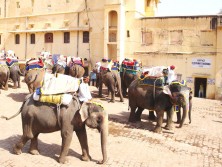
The fabled “Pink City” of northwestern India’s Thar desert, Jaipur is the capital of Rajasthan state and one of the most popular destinations for foreign visitors to India. Jaipur’s sandy surroundings, abundant Islamic architecture and rosy terracotta coloring give it a decidedly Middle Eastern feel, separate from much of the rest of India.
The problem many visitors to Jaipur face is not a lack of things to do but in fact, an overabundance of activities and attractions. The list I present here is far from all-encompassing, but should provide you with ideas on how to get your Jaipur adventure started.

Ride an elephant up the Amber Fort in Jaipur.
Amber Fort
Although I rarely travel with a set plan in mind, one goal I was adamant on achieving in India was riding an elephant. Unfortunately, I didn’t encounter the chance to ride one during the first half of my trip, such as in Agra (near the Taj Mahal) or the capital city of Delhi.
When I arrived at Amber Fort, a 400-year old royal palace located about 10 km outside the city center, it became immediately obvious that my wish was about to come true. After a few minutes at the “Elephant Booking Office” — and paying a fee of Rs. 750, or about $15 — I was on my way up to the top of the fort, built by Raja Man Singh of the Kachwahas Rajput.
The fort isn’t actually amber in hue but yellow — its name refers not to its coloring, but rather to the fact that it was named after the ancient town of Amber, built in honor of the goddess Amba. As for the elephant ride, you’ll be surprised how smooth it is, even if it’s scary the first few seconds you get off the ground.

Pay a visit to the Jaipur City Palace
Jaipur City Palace
If you’re tired from an inbound Indian train journey or flight, you might instead want to begin your time in Jaipur with a trip to the Jaipur City Palace, located not surprisingly within the city center. In fact, it occupies more than 10 per cent of the entire walled city.
Blending local Rajput architecture with classic north Indian Mughal architecture (the Taj Mahal is one example of the latter), the City Palace was home to the Maharaja of Jaipur and dates back to 1732. The City Palace was built by Sawai Jai Singh II, who reigned over Amber, namesake of the aforementioned Amber Fort.
Admission to the Jaipur City Palace include a complimentary audio tour, which takes you through the Palace room by room and explains the importance of each to you. Perhaps the most fascinating thing about the Jaipur City Palace is that although a small portion of it has been converted into a public museum, descendants of the royal family still call the City Palace home.

Enter the world of ancient astronomy at the Jantar Mantar Observatory.
Jantar Mantar Observatory
In spite of the recent media rumblings about India’s space program, astronomy is probably the last thing that comes to your mind when you think about India. A trip to the Jantar Mantar observatory, located literally a stone’s throw from the City Palace, will cast asides any doubts you might have about Indian astronomical prowess.
Built around the same time as the Jaipur City Palace by the same ruler, Jai Singh II, the observatory is home to more than a dozen ancient time measurement, star tracking and even eclipse-predicting devices. Of course, you’d never guess that most of the equipment here was used for its actual intended purpose, so do take care to read the informational placards in front of each of them.

They call it the Monkey Temple for a reason!
Monkey Temple and Sun Temple
If you climb up the hill that rises behind the eastern gate of the Pink City, you will search the Sun Temple, or “Suriya Mandir.” Although the temple itself is nothing particularly special, the panorama of Jaipur you enjoy from its summer is really something else.
Located at the bottom of the Sun Temple hill is the aptly-named Monkey Temple, which is also known by its local name “Galwh Bagh.” Although the monkeys that call this temple home are allegedly tame and love to be fed, I kept my distance when I visited — I didn’t want rabies! Still, they were extremely cute.

The hotel Umaid Bhawan has a luxurious feel at an affordable price point.
Jaipur Hotels
As is the case in most of the rest of India, a nice Jaipur hotel room can be yours for next to nothing. Although extremely luxurious Jaipur hotels — such as the seven-star one Anderson Cooper and his boyfriend stayed in when they visited in late 2009 — you can still in someplace extremely comfortable and stylish for much less than the $3,200 per night Andy and his man paid.
I highly recommend the Hotel Umaid Bhawan, a four-star property where double rooms start at just Rs. 1,600 (about $32) per night. No matter where you choose to stay in Jaipur, however, you won’t soon forget your experience in India’s charming Pink City.

Robert Schrader is a travel writer and photographer who’s been roaming the world independently since 2005, writing for publications such as “CNNGo” and “Shanghaiist” along the way. His blog, Leave Your Daily Hell, provides a mix of travel advice, destination guides and personal essays covering the more esoteric aspects of life as a traveler.








